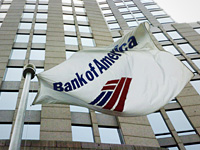Bank of America is sending out far more foreclosure notices to borrowers.
By Diana Olick
Bank of America is ramping up its foreclosure processing, sending out far more notices of default to borrowers in August than in previous months, well over 200 percent more month-to-month.
A notice of default is the first stage of the foreclosure process in non-judicial foreclosures states, that is, where foreclosures do not go before a judge.
The notice of default is usually sent when a borrower is 90 days or more overdue in payments, but that timeline has been extended significantly during this housing crisis, due to the so-called “robo-signing” processing scandal and the sheer volume of troubled loans.
Mortgage and housing analyst and strategist Mark Hanson alerted me to unusually high legal default filing activity, and his research points to Bank of America as the primary driver. I contacted a Bank of America spokesman, who responded:
“It appears the numbers you noted to me this afternoon generally track with our own numbers for key categories. It should be noted it’s driven more in key states like California and Nevada than overall, and certainly the progress we’re seeing is limited to non-judicial states. Judicial states continue to move very slowly, with key states like New Jersey only beginning to start processing foreclosures again this month.”
The foreclosure numbers are down very slightly year-over-year, but only because August 2010 was one of the highest foreclosure months on record, and of course was just before the “robo-signing” scandal was uncovered. Delays in processing have artificially lowered the foreclosure numbers over the past year, so this new surge is likely addressing loans that have been long delinquent, but unaddressed.
In other words, the foreclosure pipeline is filling again.
RealtyTrac, a widely followed foreclosure sale and data site, is also confirming a surge in overall notices of default in its August numbers, to be released later this week. They do not cite Bank of America specifically, which bought Countrywide Financial, taking on millions of troubled loans.
“We’ve been seeing REO [bank-owned property] sales, and processing of loans through foreclosure. This increase may simply be the lenders and servicers starting the next cycle. August traditionally is a high month for foreclosure actions, so part of the increase might be seasonal,” says RealtyTrac’s Rick Sharga. “Could be any number of reasons – but with 3.5 million delinquent loans, this had to happen sooner or later.”
The question of course is, is this a one month catch-up purge or will it continue at high levels for a while? And if the latter, will other banks follow suit quickly? Because if other banks see Bank of America pushing more loans to foreclosure, which will inevitably means more properties heading out for sale, they may want to get in before that glut of properties pushes prices down even further.
“This proves once again that “credit” as measured by legal defaults and foreclosures is not necessarily about borrowers missing payments, rather about what the servicers chose to do about it,” notes Hanson.
Article derived from: cnbc.com
John is the Vice President here at JohnHart, and as such is responsible for managing and directing the firm towards obtaining its ultimate goals.
He is also one of our main contributors on the Blog. (please see his profile page on the main site for more information.)


